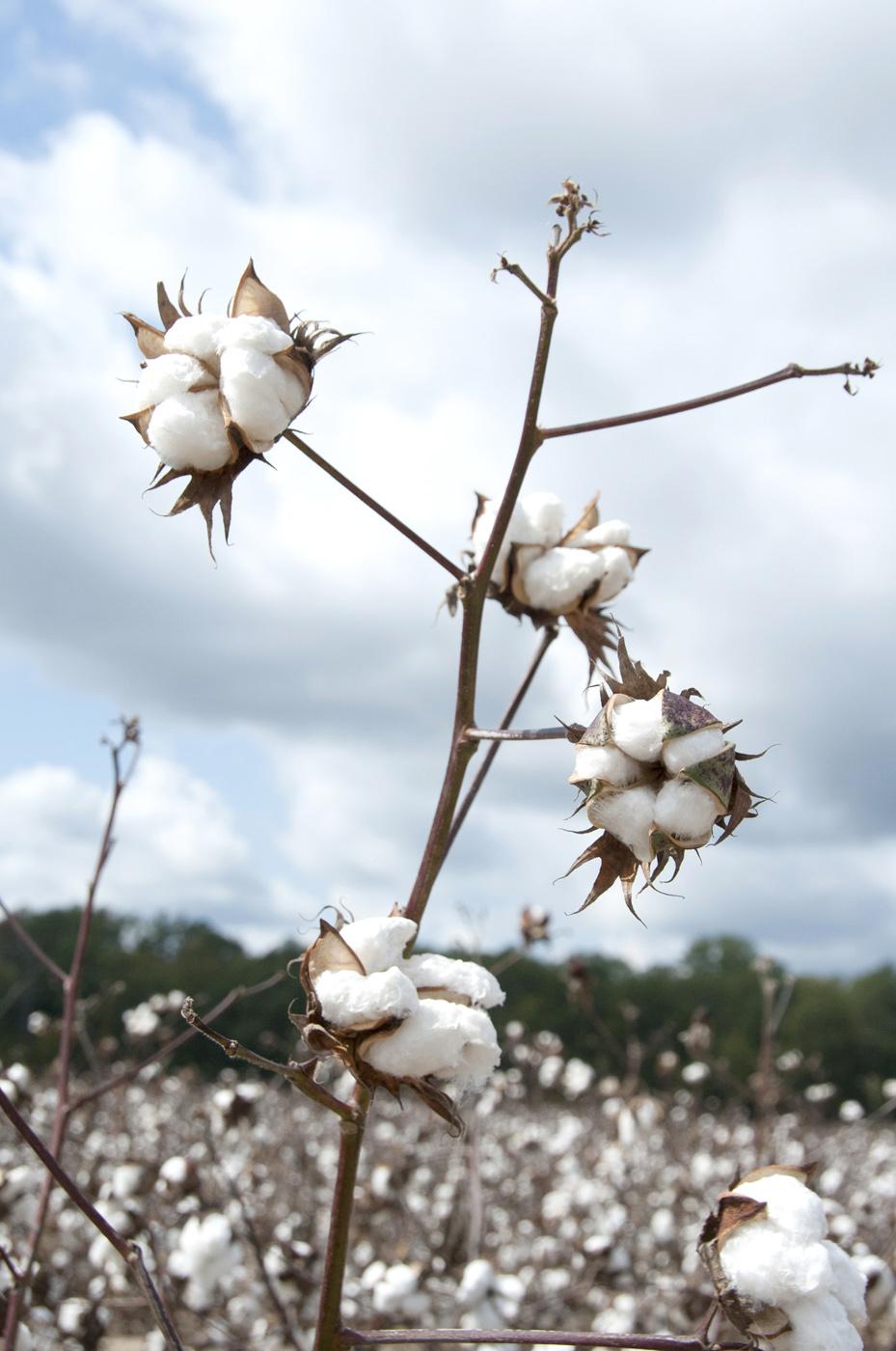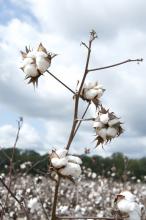Information Possibly Outdated
The information presented on this page was originally released on January 15, 2012. It may not be outdated, but please search our site for more current information. If you plan to quote or reference this information in a publication, please check with the Extension specialist or author before proceeding.
Livelihood, environment at stake in farmers' land
MISSISSIPPI STATE – Many organizations and individuals are dedicated to protecting and restoring the environment, but some would be surprised to find that farmers are one group on the forefront of these efforts.
Erick Larson, grain crops agronomist with the Mississippi State University Extension Service, said farmers are some of the biggest conservationists around.
“Farmers are continually working to improve the quality of their land and resources so it will be sustainable and more productive, even during the inevitable times of poor farming conditions,” Larson said. “Farmers depend on the land and water to earn a living this year and next year and in the future, and they want their sons and daughters and grandchildren to be able to earn a living off that land as well.”
In Mississippi, at least 98 percent of the state’s 42,300 farms are owned and operated by families, not corporations. These family farms produce 86 percent of the state’s agricultural products.
Social consciousness…
Larson said there are many misconceptions and much misinformation in the debate over whether farming, especially large-scale farming, is good or bad for the land.
“Farmers consider long-term consequences because they know the resources they are working with are not necessarily renewable,” Larson said.
Hot topics in the farming debate are bioengineering and weed and insect resistance to chemical controls. While the science is complex, the bottom line for most consumers is simple.
“The general public is more interested in whether the food they eat is safe and whether new products and technologies, such as biotechnology and herbicides, are good for the food and fiber that we produce,” Larson said.
The U.S. Department of Agriculture, the Environmental Protection Agency and the Food and Drug Administration all help regulate and enforce various aspects of food safety, chemical use and environmental monitoring.
Years of scientific testing and research back any new product or technology that becomes part of agriculture, Larson said. Tough regulations and food safety standards help ensure safe products for human consumers.
Friendly pest management…
One of the worst raps given farms is for their use of chemicals. Improper use of chemicals can lead to the development of weeds and insects that are resistant to the chemicals that once seemed like magic cures for these costly challenges.
Chemicals are labeled with safe protocol and application information, which are based on all available data.
Angus Catchot, MSU Extension entomologist, said scientific advances in insect control now allow farmers to control harmful insects without hurting beneficial insects. Current insecticides often target individual pests and are applied with precision and careful timing.
“Insecticide treatments are expensive, and farmers do not want to spray insecticides unless they have to,” Catchot said.
Scientific advances over the last few decades have introduced crops genetically engineered to resist specific, harmful pests. These crops require significantly fewer insecticide applications, which ultimately is much more environmentally friendly.
Tobacco budworms provide an example of how crops with this resistance, known as Bt or transgenic crops, reduced the need for chemicals to be sprayed on farmland.
“In 1995, cotton producers experienced an outbreak of tobacco budworms and in Mississippi averaged six insecticide applications to control this pest. Some places had to have more than 10 applications,” Catchot said. “Bt cotton controls 100 percent of tobacco budworm populations, and producers no longer treat for this pest.”
Savvy producers today control insects using sophisticated Integrated Pest Management, or IPM, techniques. Many of these techniques are the result of Mississippi Agricultural and Forestry Experiment Station research and MSU Extension Service programs that have netted better results, lower costs and fewer chemicals in the battle against bugs.
“IPM uses every tool available, which includes cultural practices, beneficial insects, scouting and insecticides when necessary, with the goal of having the least impact on the environment,” Catchot said. “It’s a multi-tactic approach that is least disruptive to anything in the environment other than the insects being controlled.”
IPM incorporates all aspects of managing pests, including how the crop is grown.
“Farmers today spend more than $100 an acre in the Delta controlling tarnished plant bugs in cotton,” Catchot said. “MSU researchers are looking at managing plant bugs by manipulating planting dates. We’re trying to show that by planting early, we can avoid up to 50 percent of the insecticides typically used to control these pests.”
Another pest under scrutiny is soybean loopers, the crop’s No. 2 pest in 2011. Soybean loopers are migratory insects that fly up from southern latitudes. Researchers have found that planting early can almost completely eliminate the need to treat for this pest.
“Farmers do have to rely on insecticides, but they’re doing so in a very calculated way to minimize the impact on the environment,” Catchot said.
Both insecticides and herbicides used to control weeds are applied with discretion on an as-needed basis when a pest is threatening to reduce the quality or yield of a crop.
Recreational uses…
While cost is part of producers’ desire to use as few chemicals as possible, they are by no means the only consideration.
Many farms today make money on more than the sale of crops. Tracts of farmland, waterways and forests adjoining farmland are leased for hunting, fishing and other recreational opportunities. These ventures bring in important revenue and give farmers who are also avid hunters or fishermen an opportunity to enjoy this use of their land.
“They’re not going to use practices on their farm that jeopardize a source of income and a recreational opportunity they enjoy for themselves and their family,” Catchot said.
Certification required…
Farmers follow careful environmental practices for financial reasons, their own ethics and personal commitment to preserving the land. Numerous regulations are in place to ensure protection of the land, the food supply, people and animals.
Tommy McDaniel, a division director in Mississippi Department of Agriculture and Commerce’s Bureau of Plant Industry, said all producers applying restricted-use pesticides must be certified to do so.
“In the registration process, pesticides are evaluated to ensure that they will not have unreasonable adverse effects on humans or the environment,” McDaniel said. “Pesticides may pose some risk to humans, animals or the environment, but they can be used safely and effectively as long as they are used according to the label directions.”
Pesticide applicator certification is a legal requirement for those applying restricted-use pesticides and or general-use products in a commercial situation. Licensing is required by both state and federal regulations, and the responsibility for providing this training has been given to the MSU Extension Service.
“The pesticide label contains pertinent information that should be understood and followed when using a pesticide,” McDaniel said.
Big picture…
Mississippi farmers do all they can to make a living and sustain the environment, and the result is good for consumers and the economy.
Ken Hood, an MSU Extension agricultural economist, said large commercial farms are key to the United States’ ability to feed the world.
“The first step to becoming an industrialized nation with a vibrant economy is to be able to provide the basic needs for your own population,” Hood said. “Agriculture provides food and clothing. Once you meet these needs, you can release labor to other sectors of the economy and increase economic development.”
Third World countries do not have the ability to supply their population’s basic needs, and they rely on these being supplied by U.S. farmers and those of other industrialized nations.
“We provide what we need plus a lot more,” Hood said. “Big producers are providing for the needs of ourselves and other countries, and that allows us to release productive units to do other things.”






